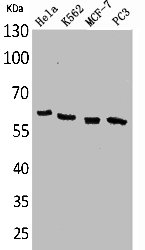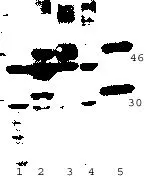p63 antibody [N2C1], Internal
GTX102425
ApplicationsImmunoFluorescence, ImmunoPrecipitation, Western Blot, ImmunoCytoChemistry, ImmunoHistoChemistry, ImmunoHistoChemistry Frozen, ImmunoHistoChemistry Paraffin, Other Application
Product group Antibodies
TargetTP63
Overview
- SupplierGeneTex
- Product Namep63 antibody [N2C1], Internal
- Delivery Days Customer9
- Application Supplier NoteWB: 1:500-1:3000. ICC/IF: 1:100-1:1000. IHC-P: 1:100-1:1000. IP: 1:100-1:500. *Optimal dilutions/concentrations should be determined by the researcher.Not tested in other applications.
- ApplicationsImmunoFluorescence, ImmunoPrecipitation, Western Blot, ImmunoCytoChemistry, ImmunoHistoChemistry, ImmunoHistoChemistry Frozen, ImmunoHistoChemistry Paraffin, Other Application
- CertificationResearch Use Only
- ClonalityPolyclonal
- Concentration1.37 mg/ml
- ConjugateUnconjugated
- Gene ID8626
- Target nameTP63
- Target descriptiontumor protein p63
- Target synonymsAIS, B(p51A), B(p51B), EEC3, KET, LMS, NBP, OFC8, RHS, SHFM4, TP53CP, TP53L, TP73L, p40, p51, p53CP, p63, p73H, p73L, tumor protein 63, amplified in squamous cell carcinoma, chronic ulcerative stomatitis protein, keratinocyte transcription factor KET, transformation-related protein 63, tumor protein p53-competing protein
- HostRabbit
- IsotypeIgG
- Protein IDQ9H3D4
- Protein NameTumor protein 63
- Scientific DescriptionThis gene encodes a member of the p53 family of transcription factors. An animal model, p63 -/- mice, has been useful in defining the role this protein plays in the development and maintenance of stratified epithelial tissues. p63 -/- mice have several developmental defects which include the lack of limbs and other tissues, such as teeth and mammary glands, which develop as a result of interactions between mesenchyme and epithelium. Mutations in this gene are associated with ectodermal dysplasia, and cleft lip/palate syndrome 3 (EEC3); split-hand/foot malformation 4 (SHFM4); ankyloblepharon-ectodermal defects-cleft lip/palate; ADULT syndrome (acro-dermato-ungual-lacrimal-tooth); limb-mammary syndrome; Rap-Hodgkin syndrome (RHS); and orofacial cleft 8. Both alternative splicing and the use of alternative promoters results in multiple transcript variants encoding different proteins. Many transcripts encoding different proteins have been reported but the biological validity and the full-length nature of these variants have not been determined. [provided by RefSeq]
- Storage Instruction-20°C or -80°C,2°C to 8°C
- UNSPSC12352203
References
- Yamamoto S, Matsui K, Kinoshita Y, et al. Successful reconstruction of the rat ureter by a syngeneic collagen tube with a cardiomyocyte sheet. Regen Ther. 2023,24:561-567. doi: 10.1016/j.reth.2023.10.001Read this paper
- Lee JM, Lim TY, Oh SB, et al. Ahnak is required to balance calcium ion homeostasis and smooth muscle development in the urinary system. Cell Biosci. 2023,13(1):108. doi: 10.1186/s13578-023-01055-xRead this paper
- Russell SK, Harrison JK, Olson BS, et al. Uropathogenic Escherichia coli infection-induced epithelial trained immunity impacts urinary tract disease outcome. Nat Microbiol. 2023,8(5):875-888. doi: 10.1038/s41564-023-01346-6Read this paper
- Neumayer G, Torkelson JL, Li S, et al. A scalable, GMP-compatible, autologous organotypic cell therapy for Dystrophic Epidermolysis Bullosa. bioRxiv. 2023,:pii: 2023.02.28.529447. doi: 10.1101/2023.02.28.529447.Read this paper
- Bedos L, Wickham H, Gabriel V, et al. Culture and characterization of canine and feline corneal epithelial organoids: A new tool for the study and treatment of corneal diseases. Front Vet Sci. 2022,9:1050467. doi: 10.3389/fvets.2022.1050467Read this paper
- Huang H, Fang Y, Jiang M, et al. Contribution of Trp63(CreERT2)-labeled cells to alveolar regeneration is independent of tuft cells. Elife. 2022,11. doi: 10.7554/eLife.78217Read this paper
- Huang H, Liu J, Li M, et al. Cis-regulatory chromatin loops analysis identifies GRHL3 as a master regulator of surface epithelium commitment. Sci Adv. 2022,8(28):eabo5668. doi: 10.1126/sciadv.abo5668Read this paper
- Kadur Lakshminarasimha Murthy P, Sontake V, Tata A, et al. Human distal lung maps and lineage hierarchies reveal a bipotent progenitor. Nature. 2022,604(7904):111-119. doi: 10.1038/s41586-022-04541-3Read this paper
- Chalmers FE, Dusold JE, Shaik JA, et al. Targeted deletion of TGFβ1 in basal keratinocytes causes profound defects in stratified squamous epithelia and aberrant melanocyte migration. Dev Biol. 2022,485:9-23. doi: 10.1016/j.ydbio.2022.02.009Read this paper
- Mou H, Yang Y, Riehs MA, et al. Airway basal stem cells generate distinct subpopulations of PNECs. Cell Rep. 2021,35(3):109011. doi: 10.1016/j.celrep.2021.109011Read this paper


![IHC-P analysis of human prostate carcinoma tissue using GTX18022 p63 antibody [TP63/2427].](https://www.genetex.com/upload/website/prouct_img/normal/GTX18022/GTX18022_20200115_IHC-P_1044_w_23060620_814.webp)
![IHC-P analysis of human prostate carcinoma tissue using GTX18023 p63 antibody [TP63/2428].](https://www.genetex.com/upload/website/prouct_img/normal/GTX18023/GTX18023_20200115_IHC-P_1045_w_23060620_173.webp)

![ELISA analysis of antigen using GTX60407 p63 antibody [4E5]. Red : Control antigen 100ng Purple : Antigen 10ng Green : Antigen 50ng Blue : Antigen 100ng](https://www.genetex.com/upload/website/prouct_img/normal/GTX60407/GTX60407_20170912_ELISA_w_23061123_931.webp)
![IHC-P analysis of human prostate tissue using GTX01961 p63 antibody [7JUL].](https://www.genetex.com/upload/website/prouct_img/normal/GTX01961/GTX01961_20200811_IHC-P_68_w_23053121_325.webp)